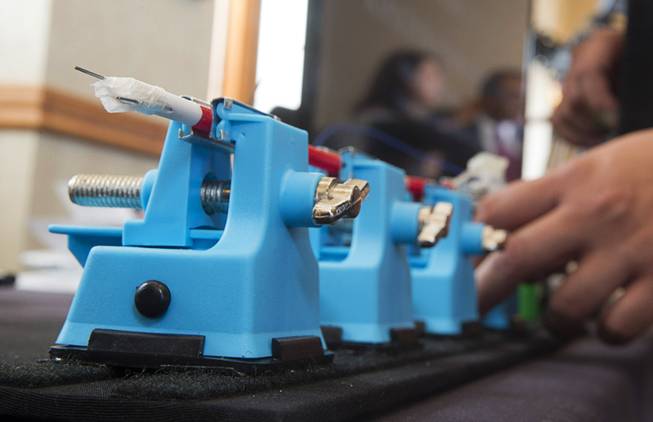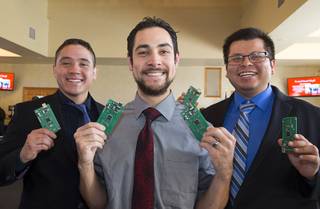
A prototype device for applying anesthetic from inside a vein is displayed during a UNLV Senior Design showcase at UNLV Wednesday, Dec. 7, 2016. The device shown is two times the actual size. The system would be used in the treatment of varicose veins.
Friday, Dec. 9, 2016 | 2 a.m.
Less than two weeks from graduation, some UNLV students seem a bit more prepared for taking on the challenges of the real world.
On Wednesday, 64 engineering students competing on 25 teams participated in the Fred and Harriet Cox Senior Design Competition — a biannual showcase of technological innovation and engineering acuity.
A panel of local tech industry leaders judged the students’ efforts, with nearly $20,000 in cash to be awarded. Best in show will receive a $4,000 grand prize. Prizes of $1,500 for first and $750 for second will be awarded in multiple categories. Winners will be announced at an awards banquet next week.
The competition required students to work in teams across engineering disciplines to create a prototype.
“Engineering should be a hands-on experience,” said Rama Venkat, dean of UNLV’s college of engineering. “Senior Design students learn by addressing the engineering challenge, but also from the real-world practicality of building a prototype and having to work in groups to solve a real community problem.”
Venkat co-founded the event in 1999 when he was an engineering faculty member with an interest in technology and entrepreneurship and $500 left over from a budget for senior projects.
That seed money spawned a competition, which last year received a $3 million endowment from Fred and Harriet Cox to permanently fund prize money, the awards ceremony and up to $2,000 for each team to purchase materials for its prototype.
Among the displays: A vibration dampener to stabilize longboard skateboards that can wobble dangerously when downhill skaters reach car-like speeds; a set of wireless sensors for cardiac stress tests; and a drainage system that uses porous cement to eliminate flooding problems around campus.
Civil engineering senior Tori Dickey’s team addressed a near-daily traffic pile-up around a campus parking garage at Maryland Parkway and Cottage Grove Avenue.
“If you ever had to sit in traffic at this intersection, you’d know exactly why we chose this as our problem to address,” said Dickey, who will start as an engineer for Southwest Gas after graduation later this month. “It’s one of those intersections you curse.”
Her team devised a low-cost way (less than $1 million) to create a new strip of road and install a traffic light to reduce the congestion. They used a virtual-reality headset to make their calculations more accurate.
Another team developed “Tactical Smart Magz,” an attachment that displays the count of bullets remaining in a semi-automatic weapon’s magazine, which could have great use for the military and law enforcement.
Beyond the engineering challenges of adapting sensitive magnets for warlike environments, they faced obstacles in wanting to show their prototype. “You don’t really want to be walking onto a university campus with an AR-15 these days,” team member and engineering senior Alex Smith said. (The group received special permission to bring live ammunition on campus to complement a video presentation shot at a nearby gun range.)
Cody Glaiel was part of a team in the relatively new entertainment engineering track.
They built a wireless robotic drum kit that uses finger keys to control plastic robotic arms. “A lot of people would love to have this technology where they could play instruments all over a stadium or theater, with one guy, in one spot, controlling it all.”
While an immediate application would be for a performance like Blue Man Group or a Cirque du Soleil show, Glaiel said “Beatmaster” could also help make music more real for people with disabilities.
“Let’s say you have a kid with cerebral palsy,” said Glaiel, himself a drummer as well as an engineering senior. “A lot of mobile apps allow you to play musical sounds, but this allows you to experience playing the actual instrument.”
Their next steps could include pursuing a patent. Assisting students through the patent process has been a priority for UNLV in recent years.
The Senior Design class and competition have led to at least three patents and startup Dronesmith Technologies in Henderson.


Join the Discussion:
Check this out for a full explanation of our conversion to the LiveFyre commenting system and instructions on how to sign up for an account.
Full comments policy